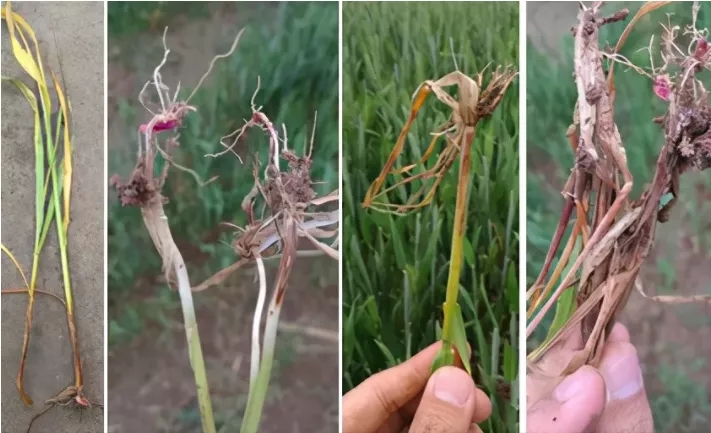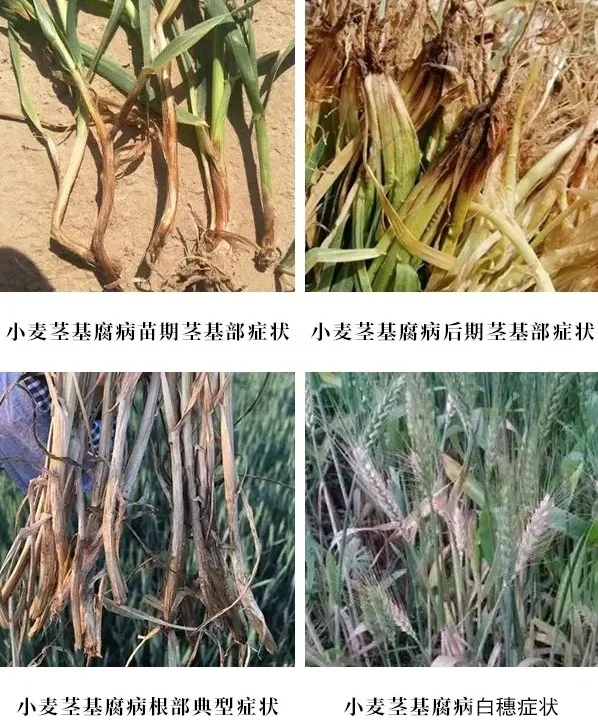邮箱:amanda@sixf.com.cn 电话: 400-6597-130
To Prevent and Control Wheat Stem Rot, We will Use a New Pac
2025-04-15 14:44
With the rise of temperature in winter wheat areas, the occurrence of wheat diseases and pests is also increasing. Among them, the worrying wheat stem rot disease has reappeared! Some areas are still very serious.

Wheat stem rot is a fungal disease and a soil-borne disease. The obvious characteristic after the early damage is the browning of the roots. The 1-2 nodes of the roots are brown. In severe cases, they turn dark brown and begin to die. In addition, red or white mold may appear on the roots of wheat in high humidity or in the middle and late stages.
There are three typical symptoms of the disease:
(1) Dead seedlings and rotten seeds.This situation often occurs when the seeds are infected by pathogens before germination, causing wilting in the seedling stage, the leaf sheaths and stems at the base of the stem turning brown, and also manifesting as rot in the wheat roots.
(2) The base of the stem turns brown.This condition often occurs during the wheat growth period, with browning of 1 to 2 nodes at the base of the stem, which may extend to the 6th node in severe cases, but will not affect the ear. In rainy and humid conditions, red or white mold may be seen at the nodes.
(3) White spike.In the affected wheat fields, sporadic white ears of wheat died, resulting in a significant reduction in wheat production.

The disease can occur from wheat tillering to wheat yellow maturity, with two main peaks of incidence. One peak is from February to early to mid-March, the incidence is stable in late March, and begins to rise again in early April. The second peak of incidence begins from mid-April to mid-May. The diseased plant rate generally reaches more than 60%, and can reach 84.2% in severe cases.
药剂防治
During the greening and jointing stage of wheat, you can use SixF Wanmukang® (30% prothioconazole + 400g/L penthioconazole·myclobutanil + water-soluble fertilizer containing amino acids + 0.01% 24-epibrassinolide) for prevention and control.

SixF Wanmukang® is a new generation of yield-increasing package that integrates disease prevention, disease treatment and yield increase. It has a unique mechanism of action. It inhibits the synthesis of ergosterol in fungi, causing the instability of fungal cell membranes and the decomposition and death of fungi, thereby controlling the occurrence and spread of diseases. It has good systemic activity and excellent protection, treatment and eradication activity.
When preventing and controlling, use fifteen set of Wanmukang per Ha of land, and use 30-45 buckets of water per Ha. Use enough medicine and water, and apply the medicine to the base of wheat seedlings in the morning when the dew has not dried or in the evening, so that the liquid medicine can easily flow to the base of the wheat stem until it reaches the diseased part, which can significantly improve the prevention effect. If there is no dew, be sure to increase the amount of water used for spraying so that the liquid medicine flows to the base of the stem.
Copyright © 2020-2021 SixF Crop Protection Co., Ltd. All rights reserved Powered by SIXF